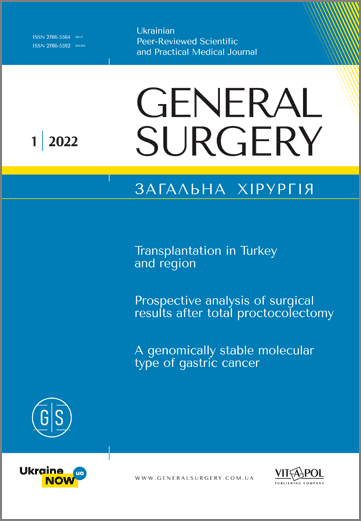Cervical mediastinoscopy in diagnosis and treatment of lung cancer
DOI:
https://doi.org/10.30978/GS-2022-1-43Keywords:
mediastinoscopy, lung cancer, mediastinal lymphadenopathyAbstract
Lung cancer remains the leading cause of cancer mortality. It ranks first in the incidence of cancer in the world. According to the European Association of Oncologists, the annual incidence of lung cancer is increasing with every passing year and amounts to about 1.8 million new cases worldwide. Men have a higher prevalence of lung cancer (33.8 per 100,000) than their female counterparts (13.5 per 100,000). In most cases, it is diagnosed at an advanced stage (III — IV), which is characterised by mediastinal lymphadenopathy. Early detection of lung cancer allows seeking early treatment. Lung cancer screening is used to find a tumour and/or lung cancer metastasis, determine its location and size as well as its morphological verification.
Objective — to define the most accurate invasive and non‑invasive methods of verification and diagnosis of mediastinal lymphadenopathy and improve diagnosis and treatment of lung cancer through the extensive use of cervical mediastinoscopy and creation of an algorithm for its optimal use.
Materials and methods. The study included 146 patients. A wide range of clinical, laboratory, endoscopic (Endobronchial ultrasound transbronchial needle aspiration (EBUS‑TBNA), Cervical Mediastinoscopy (CM)), radiographical (Computed tomography (CT), Positron emission tomography (PET)), morphological, immunohistochemical and statistical methods were used. Statistical analysis was performed using Statistics for Windows Version 10.0 (Stat Soft Inc., USA).
Results. The study involved 146 patients who underwent screening for mediastinal lymphadenopathy using mediastinoscopy. According to the laboratory findings, 98 patients had lung cancer. The rest of the cases were presented by other pathologies. Colorectal and stomach cancers were most commonly seen. In one case, the patient had a comorbidity, a combination of lung cancer and colorectal cancer.
Conclusions. Mediastinoscopy is the most effective diagnostic method for mediastinal lymphadenopathy, especially in lung cancer.
References
Carlens E. Mediastinoscopy: A method for inspection and tissue biopsy in the superior mediastinum. Diseases of the Chest. 1959;36(4):343-52. doi: 10.1378/chest.36.4.343.
Chauhan Kapoor S, Mand Ganguly, Nath P. Cervical mediastinoscopy: a re-evaluation of an old technique in era of new imaging technology Indian J. Chest Dis. 2012;(54):169-73.
De Groot P, Wu C, Carter B, Munden R. The epidemiology of lung cancer. Translational Lung Cancer Research. 2018;7(3):220-33. doi: 10.21037/tlcr.2018.05.06.
Goldstraw P, Kurzer M, Edwards D. Preoperative staging of lung cancer: accuracy of computed tomography versus mediastinoscopy. Thorax. 1983;38(1):10-5. doi: 10.1136/thx.38.1.10.
Hammoud Z, Anderson R, Meyers B, et al. The current role of mediastinoscopy in the evaluation of thoracic disease. The Journal of Thoracic and Cardiovascular Surgery. 1999;118(5):894-9. doi: 10.1016/s0022-5223(99)70059-0.
Harewood G, Wiersema M, Edell E, Liebow M. Cost-minimization analysis of alternative diagnostic approaches in a modeled patient with non-small cell lung cancer and subcarinal lymphadenopathy. Mayo Clinic Proceedings. 2002;77(2):155-64. doi: 10.4065/77.2.155.
Harken D, Black H, Clauss R, Farrand R. A simple cervicomediastinal exploration for tissue diagnosis of intrathoracic disease. New England Journal of Medicine. 1954;251(26):1041-4. doi: 10.1056/NEJM195412232512602.
Jemal A, Fedewa S. Lung cancer screening with low-dose computed tomography in the United States—2010 to 2015. JAMA Oncology. 2017;3(9):1278. DOI: 10.1001/jamaoncol.2016.6416.
Jones G, Baldwin D. Recent advances in the management of lung cancer. Clinical Medicine. 2018;18(Suppl 2):s41-s46. DOI: 10.7861/clinmedicine.18-2-s41.
Malvezzi M, Carioli G, Bertuccio P, et al. European cancer mortality predictions for the year 2017, with focus on lung cancer. Annals of Oncology. 2017;28(5):1117-23. doi: 10.1093/annonc/mdx033.
Nasim F, Sabath B, Eapen G. Lung cancer. Medical Clinics of North America. 2019;103(3):463-73. DOI: 10.1016/j.mcna.2018.12.006.
Nasu S, Okamoto N, Suzuki H, et al. Comparison of the utilities of cryobiopsy and forceps biopsy for peripheral lung cancer. Anticancer Research. 2019;39(10):5683-8. DOI: 10.21873/anticanres.13766.
Serna Aryan H, Chang. An early comparison between endoscopic ultrasound-guided fine-needle aspiration and mediastinoscopy for diagnosis of mediastinal malignancy. Am Surg. 1998;64:1014-8.
Sivrikoz C, Ak I, Simsek F, Döner E, Dündar E. Is mediastinoscopy still the gold standard to evaluate mediastinal lymph nodes in patients with non-small cell lung carcinoma? The Thoracic and Cardiovascular Surgeon. 2011;60(02):116-21. doi: 10.1055/s-0030-1271148.
Song Z, Liu Y. Progress of liquid biopsy in early diagnosis of lung cancer. Zhongguofeiaizazhi = Chinese journal of lung cancer. 2018;21(8):620. DOI: 10.3779/j.issn.1009-3419.2018.08.08.
Stiles B, Pua B, Altorki N. Screening for Lung Cancer. Surgical Oncology Clinics of North America. 2016;25(3):469-79.
Yoneda K, Louie S, Shelton D. Mediastinal tumors. Current Opinion in Pulmonary Medicine. 2001;7(4):226-33. doi: 10.1097/00063198-200107000-00011.






